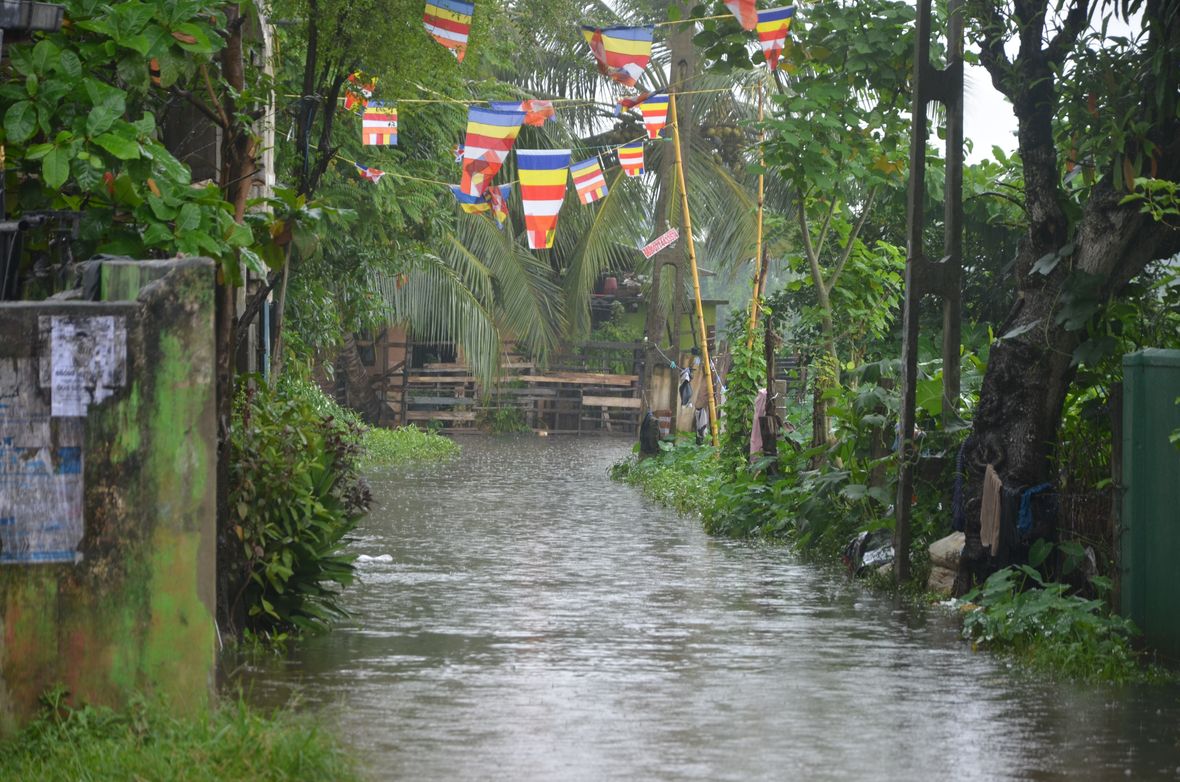Current situation:
The Disaster Management Centre (DMC) of Sri Lanka confirmed that nearly 126,000 people from 20 districts have been affected and 29 people have died due to heavy rains, strong winds, lightning and landslides. At the peak of the misery, nearly 20,000 families have been evacuated into welfare centres. Gampaha, Puttalam, Ratnapura and Colombo are amongst some of the worst affected districts.
Currently, the flood situation has started receding from the island with comparatively lesser rainfalls. Nonetheless, according to the Meteoroidal Department of Sri Lanka showers or thundershowers may occur at times in Western, Southern, Sabaragamuwa, Central and North-Western provinces. Heavy falls of 100 mm can be expected in some places and strong gusty winds up to 50 kmph can be expected over the Southern province. The water level of “Kalu Ganga” which runs through the southern part of the country is still at flood level, but is slowly receding. Gates of some of the water reservoirs have been opened and water through the channels has been released to reduce the threat of flooding in the watershed. Landslide warnings are still active in some districts due to the risk of landslides and power cuts and failures.
According to scientific figures on climatic conditions in South Asia, the beginning of the annual southeast monsoon season is occurring, and weather conditions can worsen in the coming months not only in Sri Lanka but also in the rest of South Asia.
Response:
Since the onset of the floods, the Government of Sri Lanka with the cooperation of national and international non-government organizations (NGOs) has been assisting flood-affected communities. The relief assistance started with providing cooked meals and health care facilities including administration of first aid, and distribution of non-food items (NFI), such as standard hygiene pack (adult and baby), sleeping mats, lanterns and bedsheets. Most importantly, the military deployed forces and infrastructure to conduct search and rescue operations in highly affected and vulnerable areas.
Health issues:
Following the flood in Southern Province a common virus flu (described as pneumonia) is rapidly spreading mostly among babies and infants of Sri Lanka. The fast spreading virus caused the 14 fatalities including 11 children. The Ministry of Health also warned people that diseases such as dengue, cholera and other skin related disorders could spread in the areas affected by floods with receding floodwaters.
Literature:
Decadal Data on Number of Lives Lost and Total Population Affected due to Floods
(Source: Sri Lanka Comprehensive Disaster Management Programme 2014-2018)
Over the past fifteen years, recurring floods in the country have had an impact on almost all the districts in the country. A marked increase in number of flood affected people can be noted in 2008, 2011 and 2014 as several flood events were recorded within the same year. While loss of life remains significant, a reduction in numbers related to loss of life has been evidenced throughout the period.
The marked number of casualties are partly due to high intensity precipitation leading to flash floods which challenge the timely early warnings on water management in reservoirs and dams. Detailed analysis of daily situation reports revealed that some loss of life is due to negligence of individuals and this highlights the need for awareness and increasing response capacity.
Source: http://www.desinventar.lk/
Policies and institutions for disaster management in Sri Lanka
In May 2005, the Disaster Management Act No. 13 of 2005 was enacted which provides the legal basis for a disaster risk management in the country. The Act established the National Council for Disaster Management (NCDM), chaired by the President with participation from Opposition, minority communities and Chief Ministers of the Provinces. This high-level oversight body provides direction to disaster risk management in the country.
The National Disaster Management Plan (NDMP) was adopted by NCDM in 2013 and was approved by the Cabinet of Ministers for implementation. NDMP is the overall guiding document covering intended activities of the major phases – mitigation, preparedness, emergency operations and post disaster activities, such as relief, recovery and reconstruction. Training, public awareness and education are also covered in the above phases.
The users of this plan will be all stakeholders; officials of sub-national administrations (provincial and district); relevant officers and personnel from Governmental and Non-Governmental organizations; community leaders, private sector, civil society, professional organisations and people’s representatives. National Disaster management plan will be implemented in conjunction with other plans on related national policies.
The underlying science:
Climate change modifies and has already modified the pattern of global runoff, with some studies suggesting an increase of global runoff of approximately 4% by 1 °C global temperature rise. Further, climate change increases the frequency, intensity and severity of extreme weather events, which may result in increasing frequency and magnitude of water-related extremes. Nonetheless, ecosystem degradation, through land use change, loss of wetlands and land degradation are important drivers of increasing water-related risks.
On this World Environment Day on 5 June 2018
The World Environment Day is an important day for encouraging worldwide awareness and action for the protection of our environment. Since it began in 1974, it has grown to become a global platform for public outreach that is widely celebrated in over 100 countries. The theme for 2018’s World Environment Day is beating plastic pollution.
Abandon accumulation of plastic products pollute the environment and adversely affects the ecosystems. Then again, plastic pollution can afflict climate and induce climate change. It is evident that pollution, ecosystems, climate change and natural disasters are hoops in one chain. Therefore, on this “people’s day” let us all pledge to stop using plastic products - later you will realise that this small step has enormously contributed to lessen the human sufferings from devastating natural disasters.
Photo Credit: Madeline Dahm/IWMI HQ/Colombo Floods/24 May 2018
